Chandigarh’s famous Rock Garden is thought to be India’s second-biggest tourist attraction after the Taj Mahal. Over the decades, it has become synonymous with its creator, Nek Chand, who died on Friday at the age of 90. Yet when he began to build the Garden more than 50 years ago, his Poetry in Rocks was not just illegal, it was also an act of subversion.
It all began in the 1950s on an unvisited plot of land by Sukhna Lake, just outside Chandigarh. Nek Chand was then a road inspector in the Chandigarh Capital Project – a showcase enterprise by Jawaharlal Nehru to build Independent India's first modern city, one that involved several architects, including, the Swiss-French architect Le Corbusier.
Nek Chand’s work on the Garden began somewhat spontaneously in 1957, as he became fascinated by the rocks he saw on the long bicycle rides on his way to oversee the construction of highways to the city that was intended to be Punjab’s new capital. His commute took him past the streams that led into the Sukhna Lake and also the river Ghaggar, further away by the Shivalik foothills. The young man, who had been born in 1924, began collecting interesting stones, whose odd, often anthropomorphic shapes appeared to him “both ancient and alive”, he told one architectural historian.
Soon, he had gathered thousands of rocks, ranging from pea-sized pebbles to large boulders. It is hard to tell how Nek Chand made the transition from merely collecting rocks to creating art out of them. But the fact that he was doing this on an unused tract of land by Sukhna Lake proved providential. Northeast of Chandigarh, and abutting the city’s Sector 1, this area was outside the defined territory of the city and could not be officially developed.
The Public Works Department warehouse that stored the material used to construct the roads under his supervision was nearby, and was put to use as his passion grew. In addition, the city dump was close by. Twenty four villages in the area had been razed to provide room for the new city, and the remains of the homes there had found their way to the dump. In 1965, when Nek Chand began creating a Kingdom of Gods and Goddesses, some of this debris found its way into his imagined Kingdom of Sukhrani (named after the lake nearby). The broken clay tiles, old bathroom and sink units, bike parts, discarded fabrics and utensils were put to good use as he fashioned courtyards, the chambers of kings and queens, and sculptures depicting royal beings as well as musicians, holy men, snake charmers and water carriers.
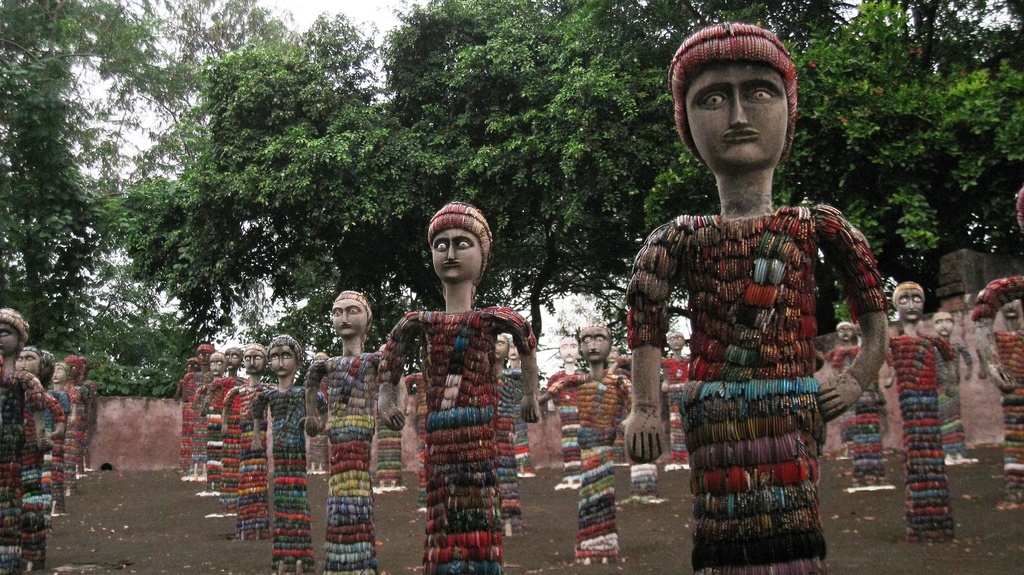
Credit: Nithya Priyan
Nek Chand worked in secret in a small hut by the light of burning tyres, leading two lives: he was a government official by day and a collector-artist by night. He is thought to have kept his passion hidden because some of the material he used was from the Public Works Store he managed, and he may occasionally have requisitioned labourers under his charge to help him with his dream world. Moreover, the city’s edict, framed by the redoubtable Le Corbusier, prohibited erection of statues anywhere in Chandigarh’s precincts. If discovered. Nek Chand risked dismissal and the destruction of his beloved creations.
There are different stories about how the site was finally discovered or how Nek Chand decided to make ts presence public. One version has it that, in 1969, fearing discovery, he approached a sympathetic government official, MN Sharma, who had worked with Le Corbusier and was the now one of the city’s leading government architects. The architect was startled at what he saw before him, and torn between ordering it to be demolished and his recognition that Nek Chand’s Garden was truly a fascinating work of art.
Another version maintains that a group of health officials stumbled on it on a malaria eradication mission in 1972. By then, nearly 2,000 sculptures stood proudly amidst the foliage, each section to the other by narrow stone pathways. A prolonged debate ensued about the Garden’s future. As hordes of curious visitors began to flock to the site, the city government became wary. The Garden’s very presence pointed to negligence on the government’s part for having let it come up in the first place. But demolishing the illegal Garden would prove unpopular.
As the debate raged for four years, Nek Chand continued work on his Garden. Finally, in 1976, an official order was passed to ensure that the Rock Garden was to be “preserved in its original form, free from the interference of architects and town planners”. Nek Chand was designated Chief Creator and assigned 50 workers to work with him. However, he objected to the site being called a “rock garden” ‒ it was not a garden of cold rocks but “poetry with rocks”, he insisted. After that, the garden expanded even more, as he built large horses and camels and even recreated a small-scale version of his ancestral village of Barian Kalan, which he had fled as a boy after Partition.
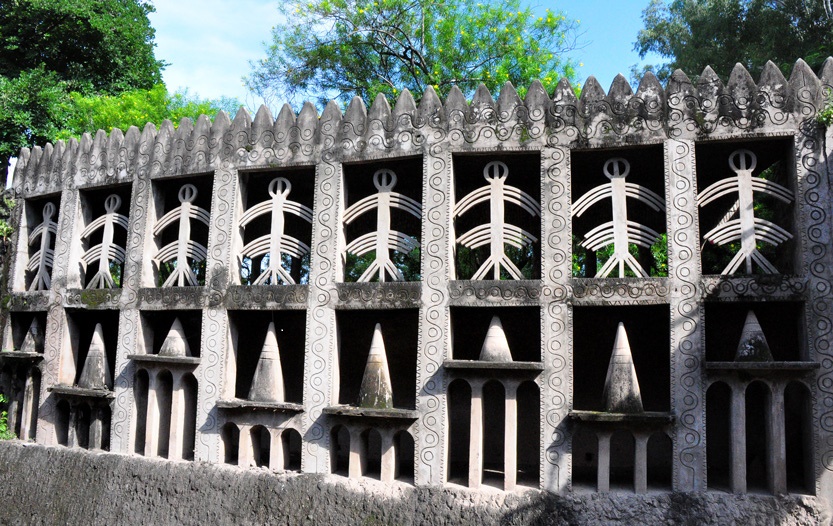
Credit: Rod Waddington
Despite its fame, the Garden has not been free of controversies. In 1990, a part of the Garden was ordered to be demolished for a road project. The bulldozers were stopped by a human wall of children, artists and other protestors. In 1996, when Nek Chand was on a visit to the US, some of the figures were vandalised by miscreants.
Meanwhile, as the popularity of the Rock Garden grows, the Chandigarh government has approved a plan to introduce night lighting in to mine its tourism potential. An expansion of the Garden has also been mooted.
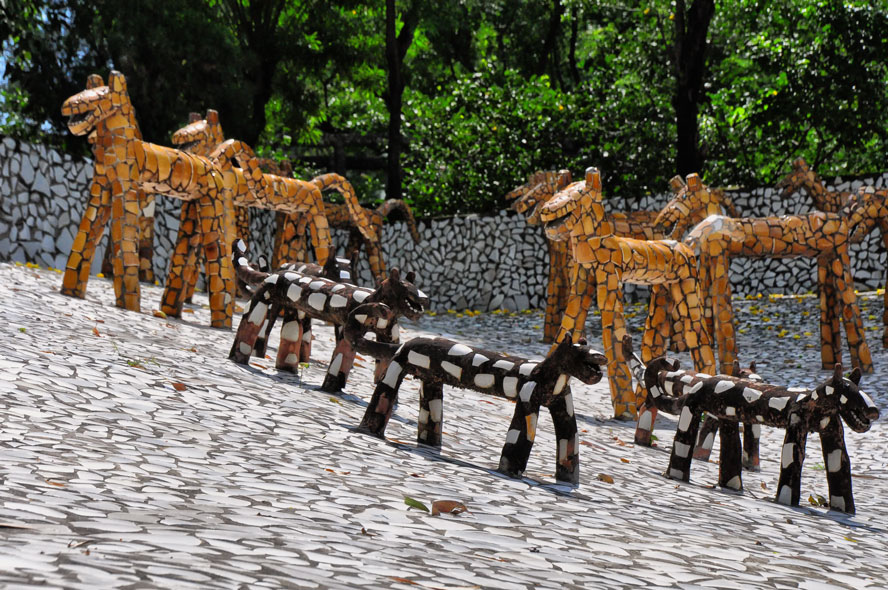
Credit: Rod Waddington
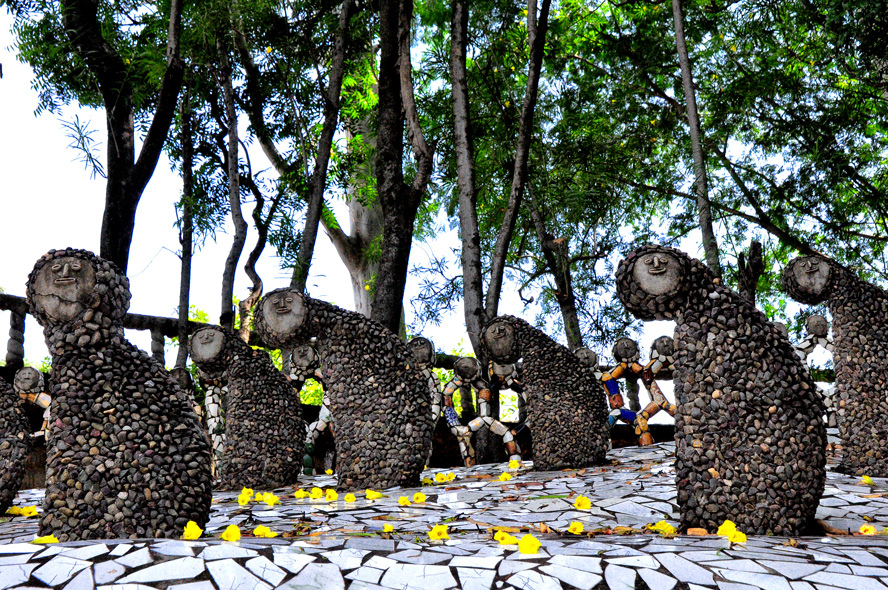
Credit: Rod Waddington
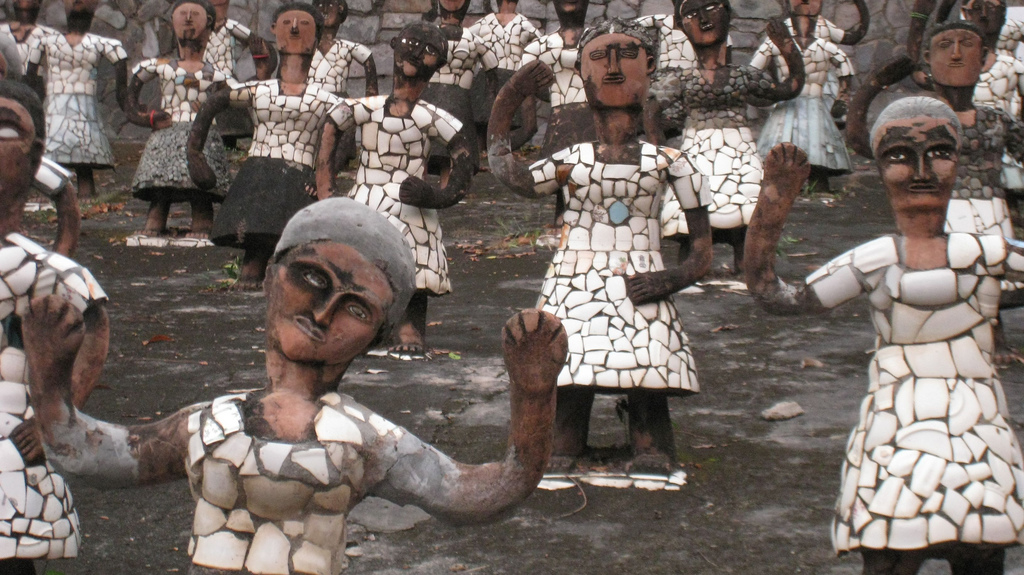
Credit: Nithya Priyan

Credit: Lian Chang
It all began in the 1950s on an unvisited plot of land by Sukhna Lake, just outside Chandigarh. Nek Chand was then a road inspector in the Chandigarh Capital Project – a showcase enterprise by Jawaharlal Nehru to build Independent India's first modern city, one that involved several architects, including, the Swiss-French architect Le Corbusier.
Nek Chand’s work on the Garden began somewhat spontaneously in 1957, as he became fascinated by the rocks he saw on the long bicycle rides on his way to oversee the construction of highways to the city that was intended to be Punjab’s new capital. His commute took him past the streams that led into the Sukhna Lake and also the river Ghaggar, further away by the Shivalik foothills. The young man, who had been born in 1924, began collecting interesting stones, whose odd, often anthropomorphic shapes appeared to him “both ancient and alive”, he told one architectural historian.
Soon, he had gathered thousands of rocks, ranging from pea-sized pebbles to large boulders. It is hard to tell how Nek Chand made the transition from merely collecting rocks to creating art out of them. But the fact that he was doing this on an unused tract of land by Sukhna Lake proved providential. Northeast of Chandigarh, and abutting the city’s Sector 1, this area was outside the defined territory of the city and could not be officially developed.
The Public Works Department warehouse that stored the material used to construct the roads under his supervision was nearby, and was put to use as his passion grew. In addition, the city dump was close by. Twenty four villages in the area had been razed to provide room for the new city, and the remains of the homes there had found their way to the dump. In 1965, when Nek Chand began creating a Kingdom of Gods and Goddesses, some of this debris found its way into his imagined Kingdom of Sukhrani (named after the lake nearby). The broken clay tiles, old bathroom and sink units, bike parts, discarded fabrics and utensils were put to good use as he fashioned courtyards, the chambers of kings and queens, and sculptures depicting royal beings as well as musicians, holy men, snake charmers and water carriers.

Credit: Nithya Priyan
Nek Chand worked in secret in a small hut by the light of burning tyres, leading two lives: he was a government official by day and a collector-artist by night. He is thought to have kept his passion hidden because some of the material he used was from the Public Works Store he managed, and he may occasionally have requisitioned labourers under his charge to help him with his dream world. Moreover, the city’s edict, framed by the redoubtable Le Corbusier, prohibited erection of statues anywhere in Chandigarh’s precincts. If discovered. Nek Chand risked dismissal and the destruction of his beloved creations.
There are different stories about how the site was finally discovered or how Nek Chand decided to make ts presence public. One version has it that, in 1969, fearing discovery, he approached a sympathetic government official, MN Sharma, who had worked with Le Corbusier and was the now one of the city’s leading government architects. The architect was startled at what he saw before him, and torn between ordering it to be demolished and his recognition that Nek Chand’s Garden was truly a fascinating work of art.
Another version maintains that a group of health officials stumbled on it on a malaria eradication mission in 1972. By then, nearly 2,000 sculptures stood proudly amidst the foliage, each section to the other by narrow stone pathways. A prolonged debate ensued about the Garden’s future. As hordes of curious visitors began to flock to the site, the city government became wary. The Garden’s very presence pointed to negligence on the government’s part for having let it come up in the first place. But demolishing the illegal Garden would prove unpopular.
As the debate raged for four years, Nek Chand continued work on his Garden. Finally, in 1976, an official order was passed to ensure that the Rock Garden was to be “preserved in its original form, free from the interference of architects and town planners”. Nek Chand was designated Chief Creator and assigned 50 workers to work with him. However, he objected to the site being called a “rock garden” ‒ it was not a garden of cold rocks but “poetry with rocks”, he insisted. After that, the garden expanded even more, as he built large horses and camels and even recreated a small-scale version of his ancestral village of Barian Kalan, which he had fled as a boy after Partition.

Credit: Rod Waddington
Despite its fame, the Garden has not been free of controversies. In 1990, a part of the Garden was ordered to be demolished for a road project. The bulldozers were stopped by a human wall of children, artists and other protestors. In 1996, when Nek Chand was on a visit to the US, some of the figures were vandalised by miscreants.
Meanwhile, as the popularity of the Rock Garden grows, the Chandigarh government has approved a plan to introduce night lighting in to mine its tourism potential. An expansion of the Garden has also been mooted.

Credit: Rod Waddington

Credit: Rod Waddington

Credit: Nithya Priyan

Credit: Lian Chang
Buy an annual Scroll Membership to support independent journalism and get special benefits.

Our journalism is for everyone. But you can get special privileges by buying an annual Scroll Membership. Sign up today!
